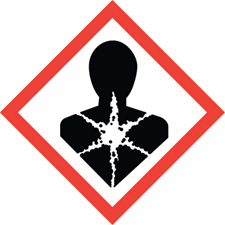Certain substances are defined as “Particularly Hazardous Substances” (PHS) by the Occupational Safety and Health Administration (OSHA) because of their potential to cause severe adverse health effects. These include carcinogens, reproductive toxins, and substances with a high acute toxicity. The increased risk associated with the use of chemicals considered to be PHS requires the implementation of stringent safety precautions and operating procedures. Laboratories using carcinogens, reproductive toxins (including teratogens and mutagens), and acutely toxicity materials must ensure these chemicals are identified, evaluated, and managed properly and that adequate protection from these hazards for laboratory personnel is provided. Standard operating procedures must be developed, and designated areas must be established if PHS are present in a laboratory.
-

The Health Hazard Pictogram is used to communicate a carcinogen hazard Carcinogens: Carcinogens are substances capable of causing cancer or tumor development. Carcinogens are chronically toxic substances in that they cause damage after repeated or long duration exposure and their effects become apparent after a long latency period. OSHA considers a chemical to be a carcinogens if it is included in any of the following lists:
- OSHA regulated carcinogens as listed in Subpart Z of the OSHA general industry standard: https://www.osha.gov/laws-regs/regulations/standardnumber/1910/1910.1003
- Material listed under the category “known to be carcinogens” in the annual Report on Carcinogens published by the National Toxicology Program (NTP): NTP Report on Carcinogens
- Material listed under Group 1 (carcinogenic to humans) by the International Agency for Research on Cancer Monographs (IARC): IARC
- Material listed in either Group 2A or 2B by IARC or under the category “reasonably anticipated to be carcinogens” by NTP and causes statistically significant tumor incidence in experimental animals.
-

The Health Hazard Pictogram is used to communicate a reproductive toxin hazard Reproductive Toxins: Reproductive toxins are chemicals that may have adverse effects on various aspects of reproduction in both women and men, including fertility, gestation/pregnancy, birth defects, lactation, genetic effects, and general reproductive performance.
- Reproductive toxins may affect reproductive capabilities by causing chromosomal damage (mutation) and adverse effects on fetal development (teratogen).
- Adverse effects of exposure may not be evident until children are desired.
- Many reproductive toxins are also classified as acutely toxic, flammable, or pyrophoric. Safe use requires assessing all potential hazards.
A list of reproductive toxins can be found at https://oehha.ca.gov/proposition-65/proposition-65-list
-

The Toxic Pictogram is used to communicate an acutely toxic hazard Acute Toxics: Chemicals are considered to have an ‘acute toxicity’ if adverse health effects occur after oral or dermal administration of a single dose of a chemical or multiple doses within 24 hours, or an inhalation exposure of four hours. These adverse effects, caused by short term exposure, can range from illness to death. OSHA states that a chemical is highly toxic if it falls within any of the following lethal dose (as determined by studies in rats) categories:
- LD50 – ingestion: < 50 mg/kg
- LD50 – contact (24hrs): < 200 mg/kg
- LD50 – inhalation: < 200 ppm/1hr
7.1 PHS Standard Operating Procedures
If PHS are present in a laboratory, a laboratory specific PHS standard operating procedure (SOP) must be developed by the PI or laboratory manager. At a minimum, the PHS SOP must contain the following information:
- Hazards associated with the material
- Procedures for safe handling and disposal
- The designated area for working with the substance
- Required personnel protective equipment
- Decontamination procedures
- Emergency response procedures
The University provides SOP templates as a resource for PI’s and laboratory managers to use to assist in the creation of laboratory specific PHS SOPs.
7.2 PHS Designated Work Areas
Designated work areas for PHS must be established in laboratories where PHS are used. The designated areas must be identified and demarcated with an appropriate posting that includes a pictogram and wording to communicate the hazards present. A designated area may be an entire laboratory, a defined area within the laboratory, or a device such as a laboratory fume hood. Contact EHSS at ehss@syr.edu to request PHS posting labels.
